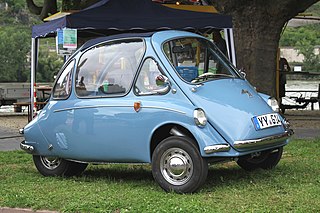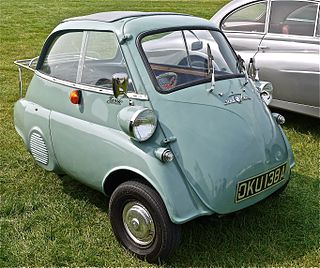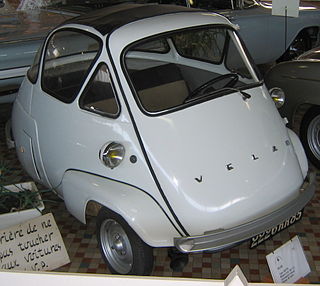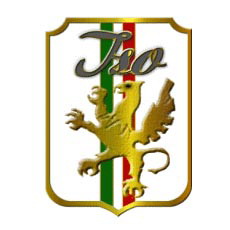
Heinkel Flugzeugwerke was a German aircraft manufacturing company founded by and named after Ernst Heinkel. It is noted for producing bomber aircraft for the Luftwaffe in World War II and for important contributions to high-speed flight, with the pioneering examples of a successful liquid-fueled rocket and a turbojet-powered aircraft in aviation history, with both Heinkel designs' first flights occurring shortly before the outbreak of World War II in Europe.

Microcar is a term often used for the smallest size of cars, with three or four wheels and often an engine smaller than 700 cc (43 cu in). Specific types of microcars include bubble cars, cycle cars, invacar, quadricycles and voiturettes. Microcars are often covered by separate regulations to normal cars, having relaxed requirements for registration and licensing.

The Isetta is an Italian-designed microcar built under license in a number of different countries, including Argentina, Spain, Belgium, France, Brazil, Germany, and the United Kingdom. Because of its egg shape and bubble-like windows, it became known as a bubble car, a name also given to other similar vehicles.

VELAM was a French automobile manufacturer that made VELAM microcars under the licence of the Isetta from the Italian Iso. Powered by a 236 cc engine, it was capable of speeds in excess of 50 mph (80 km/h). Around 5,000 cars were built between 1955 and 1959.

Trojan was a British automobile manufacturer producing light cars between 1914 and 1965, and light commercial vehicles for a short time.

ISO Rivolta is an Italian car and motorbike manufacturer active in the motor vehicle sector since 1938. Over the years, the company has taken various names, including Isothermos, Iso Autoveicoli Spa in 1952, Iso Rivolta in 1962, Iso Motors in 1973 and, in 2017, a return to ISO Rivolta.

The Messerschmitt KR200, or Kabinenroller, is a three-wheeled bubble car designed by the aircraft engineer Fritz Fend and produced in the factory of the West German aircraft manufacturer Messerschmitt from 1955 until 1964.

The Peel P50 is a three-wheeled microcar originally made from 1962 to 1965 by the Peel Engineering Company on the Isle of Man, and then from 2010 to present. It was listed in the 2010 Guinness World Records as the smallest production car ever made. The original model has no reverse gear, but a handle at the rear allows the very lightweight car to be maneuvered physically when required.

The Messerschmitt Kabinenroller was a series of microcars made by RSM Messerschmitt from 1953 to 1956 and by Fahrzeug- und Maschinenbau GmbH, Regensburg (FMR) from 1956 to 1964. All the Messerschmitt and FMR production cars used the Kabinenroller's monocoque structure, featuring tandem seating and usually a bubble canopy.

The Felber Autoroller T 400 was a three-wheeled microcar with a rear-mounted 398 cc Rotax two cylinder opposed twin, two stroke 15 metric horsepower (11 kW) engine. The cars had an unusual seating arrangement, with a small child-sized seat behind the driver on the left and a conventional passenger seat diagonally behind and to the right.

Goggomobil was a series of microcars produced by Hans Glas in the Bavarian town of Dingolfing between 1955 and 1969.

The Messerschmitt KR175 microcar (1953–1955) was the first vehicle built by Messerschmitt under its 1952 agreement with Fritz Fend. In concept, although not in actual design, it was, in principle, a development of the Fend Flitzer invalid carriage. Approximately 15,000 were built before it was replaced by the Messerschmitt KR200 in 1955.
Fritz Fend was an aeronautical engineer. He was noted for designing Messerschmitt's Kabinenroller (cabinscooter) KR175 and KR200 microcars, for co-founding FMR, the company that took over production of the Kabinenrollers in 1956, and for designing the FMR Tg500, a sports microcar based on the Kabinenroller. Fend continued his career as an inventor and designer after the KR200 ended production. Fend was working on another lightweight vehicle project shortly before his death.
Hoffmann was a bicycle manufacturer in Ratingen-Lintorf, Germany. Between 1948 and 1954 the company also manufactured motorcycles. It made a range of models using engines from 125cc to 250cc made by ILO, and the Gouverneur, which had a transversely-mounted 248 cc flat twin four-stroke engine designed by Richard Küchen, and shaft drive. The Gouverneur was developed into the MP 250-2 and finally, in 1953, the S 300 model.

The Heinkel Tourist is a motor scooter that was made by Heinkel Flugzeugwerke from 1953 to 1965. More than 100,000 were manufactured and sold.

A scooter is a motorcycle with an underbone or step-through frame, a seat, a transmission that shifts without the operator having to operate a clutch lever, a platform for their feet, and with a method of operation that emphasizes comfort and fuel economy. Elements of scooter design were present in some of the earliest motorcycles, and motor scooters have been made since at least 1914. More recently, scooters have evolved to include scooters exceeding 250cc classified as Maxi-scooters.

Lambretta is a brand of motor scooters, manufactured in Milan, Italy, by Innocenti.

The Suzuki CV1 is a microcar first presented at the 24th Tokyo Motor Show in 1981.



















